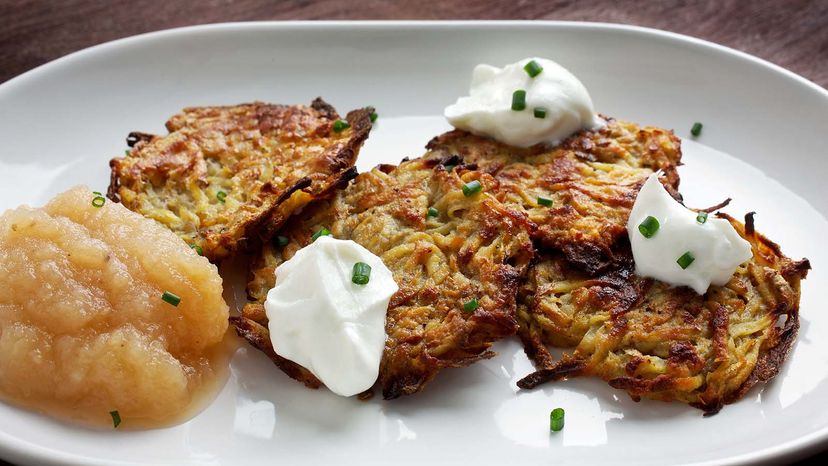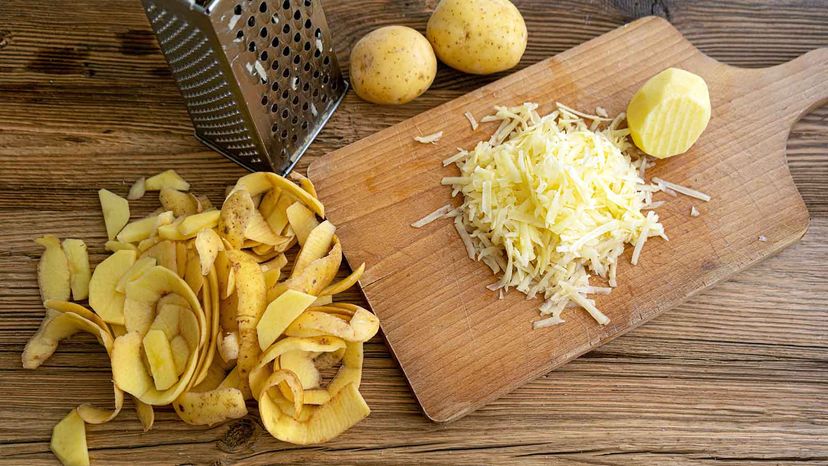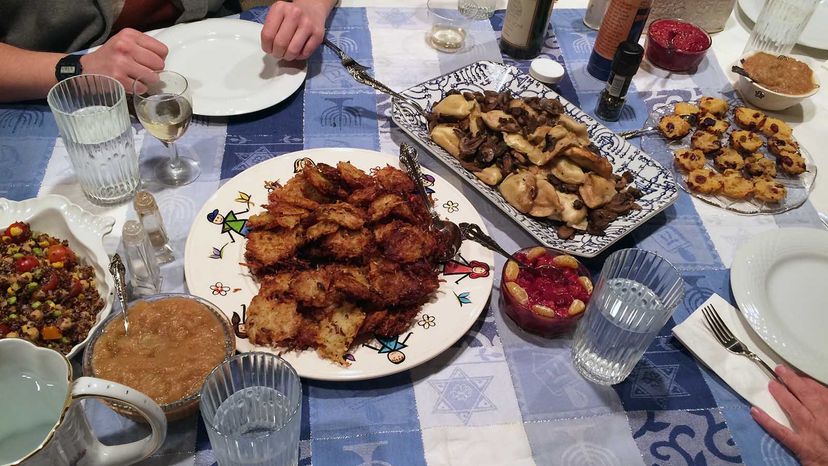By: Stephanie Vermillion|Updated: Dec 6, 2022

On the surface, latkes look like everyday potato pancakes, but these traditional holiday treats are so much more than a starchy comfort food. Latkes have been a Hanukkah staple for millennia, and have roots dating back to the 14th century, perhaps earlier.
To properly appreciate this tasty holiday tradition, we talked to expert and longtime latke enthusiast Amy Kritzer in 2019. Kritzer is a cookbook author and blogger behind What Jew Wanna Eat. Like many in the Jewish community, she's been eating latkes as long as she can remember.
Advertisem*nt
"We always eat them for Hanukkah, even though they're delicious all year," Kritzer says. "It's definitely something we look forward to making. I usually make them with my bubbe — my grandma — and my mom. It's our family tradition."
Contents
- Latkes Are a Hanukkah Staple
- What Is a Traditional Latke?
- What Do Latkes Taste Like?
Latkes Are a Hanukkah Staple
Today, latkes are synonymous with Hanukkah, but it wasn't always that way. The tradition traces back to 14th century Italy. According to "The Encyclopedia of Jewish Food," Italian Rabbi Kalonymus ben Kalonymus introduced Italian potato pancakes into Jewish tradition by including them in a poem about Hanukkah in the early 1300s.
A century later, when the Spanish expelled Jews from Sicily in the late 1400s, those in exile took southern Rome's sweet ricotta cheese pancakes — known as traditional cassola in Rome — to the Jewish community in northern Italy. These pancakes combined two traditional Jewish food types: fried (for the Jewish tradition of oil) and dairy, and thus, the Hanukkah staple was born. Over time, the latke transitioned from cheese to potato, and as PBS reports, the potato latkes gained steam in 1800s Eastern Europe because potatoes were both cheap and plentiful.
Advertisem*nt
What Is a Traditional Latke?

Traditional latkes call for grated potatoes, onions, egg, matzo meal or breadcrumbs as a binder, salt and oil. Size-wise, each latke requires about a quarter-cup scoop of latke batter, Kritzer says. Then you simply pan-fry them until the edges are golden brown. The result is a roughly 4-inch (10-centimeter) potato patty. "It's just a few bites, and you eat them with your hands," Kritzer says.
Applesauce and sour cream are the two traditional latke toppings; Kritzer's readers have serious opinions about which topping reigns supreme. "It's an extremely polarizing question," Kritzer says. "Some people say applesauce only, others say sour cream only, and some mix the two together, others keep them separate. People have their own opinions. I'm a sour cream person, but I wouldn't say no to applesauce."
Advertisem*nt
Is there a difference between latkes and, say, traditional German potato pancakes? Probably not. "When I lived in Texas, they had a large German population, and we'd go to this beer festival every year and they had potato pancakes," Kritzer says. "I'd taste them and say 'these are latkes!' They just call them potato pancakes."
What Do Latkes Taste Like?
According to Kritzer, it's a perfect mix of crispy and fluffy. "It's shredded potatoes and the best latkes are super crispy on the outside, so you bite in and get this crunchy texture, but then in the middle it's soft and fluffy," she says. "The flavor is potato, really just salty in a good way, maybe a little hint of onion. It's really just a nice fried, crispy soft potato with a little salt."
This, of course, is the simple and traditional latke. As a cookbook author and food blogger, Kritzer gets creative with her latkes, too. "One of my favorite toppings is just a little bit of cream cheese and lox, and then some other bagel toppings like an everything-bagel spice or some red onion," she says. "I've also done a latkes eggs Benedict for breakfast, and then recently I just did fried-pickles latkes, and I was really into that."
Advertisem*nt
The latke recipe may be straightforward, but that doesn't mean all latkes are the same. Kritzer says her grandma's go-to recipe calls for russet potatoes. "They're the starchiest. They're cheap, and I think they make the best latkes," she says. "She would also use some grated with onion, and would grate it with the potato, which helps keep them from browning."
Kritzer also adapted the family recipe with her own experimentations. One trick — repurposing starch — is now her go-to for ultimate crispiness.
"One thing I do now that I didn't do growing up is I save the starch from the potatoes while shredding them," she says. "I'll put them in a bowl of ice water and I squeeze all the liquid, then let the water sit for about 10 minutes. Then when you drain off the water on the bottom, there's this white starch, which is actually potato starch. I add that back to my latkes, which helps them stay crispy."

Now That's Interesting
Taste is most commonly associated with latkes, but according to Kritzer, that's not the only sense these starchy treats engage. "One thing I always remember, for better or for worse, is the smell of latkes," Kritzer says. "They stink up your entire house. I love it, but some people hate it because it smells like potatoes for weeks!"
Advertisem*nt
Cite This!
Please copy/paste the following text to properly cite this HowStuffWorks.com article:
Citation
Related Links
Advertisem*nt
Advertisem*nt
Loading...
\n\n\t\t\t\t
`;t.byline_authors_html&&(e+=`By: ${t.byline_authors_html}`),t.byline_authors_html&&t.byline_date_html&&(e+="|"),t.byline_date_html&&(e+=t.byline_date_html);var i=t.body_html.replaceAll('"pt','"pt'+t.id+"_");return e+=`\n\t\t\t\t
\n\t\t\t\t
\n\n\t\t\t\t
${i=i.replaceAll("#pt","#pt"+t.id+"_")}
\n\n\t\t\t
`}(a);this.loadedDiv.innerHTML+=n,document.title=a.title+" | HowStuffWorks";let s="content-loaded-"+a.id,l=document.getElementById(s);l.dataset.contentId=a.id;let o=l.querySelectorAll(".lazyload");HSW.utilities.lazyLoadElements(o),HSW.ux.editorial.init({twitter:!0,facebook:!0,instagram:!0}),l.querySelectorAll(".toc a").forEach(t=>{t.addEventListener("click",t=>{t.preventDefault();let e=t.target.dataset.target,i=document.querySelector("a[name='"+e+"']");i?i.scrollIntoView({behavior:"auto"}):console.error("Unable to locate target with name "+e)})});try{if(userData.adsActive)if(HSW.utilities.isMobile()){l.querySelectorAll(".ad-mobinline").forEach(t=>{t.setAttribute("id","ad-wrap-mobinline"+r),t.childNodes[0].setAttribute("id","ad-div-mobinline"+r),void 0!==HSW.ads&&HSW.pq.add(()=>{HSW.ads.addNewUnits(["ad-div-mobinline"+r])},"ads"),r++})}else{let t=document.createElement("div");t.setAttribute("id","ad-after-"+e),t.classList.add("ad-inline","mb-8","bg-gray","w-max-full","h-min-90","text-center");let a=document.createElement("div");a.setAttribute("id","ad-div-inline"+i),t.appendChild(a),l.after(t),void 0!==HSW.ads&&HSW.pq.add(()=>{HSW.ads.addNewUnits(["ad-div-inline"+i])},"ads")}}catch(t){console.error(t)}if(window.setupSinglePageUX(l),history.pushState)try{history.pushState(null,a.title+" | HowStuffWorks",a.href)}catch(t){console.warn(t)}var c=[];a.taxonomy.forEach((t,e)=>{c[e]=t.title.toLowerCase()});var d=c.join("/"),h=[];a.authors.forEach((t,e)=>{h[e]=t.first_name.toLowerCase()+" "+t.last_name.toLowerCase()});var g=h.join(",");pageMetricsData.href=a.href,pageMetricsData.title=a.title,pageMetricsData.tax=d,pageMetricsData.aType=a.asset_type,pageMetricsData.cType=a.type+"-continuous",pageMetricsData.template=a.template,pageMetricsData.source=a.source,pageMetricsData.sponsor=a.sponsor,pageMetricsData.author=g,pageMetricsData.contentid=a.id,pageMetricsData.image=a.hero_image,pageMetricsData.page=0,pageMetricsData.pubDate=a.publish_date.slice(0,10),pageMetricsData.editDate=a.last_editorial_date.slice(0,10);const u=/[^\da-z_]/i;let p=HSW.utilities.isMobile()?"hsw_lite":"hsw";a.taxonomy.slice(1,3).forEach((t,e)=>{p+="|"+t.title.replace(u,"").toLowerCase()}),pageMetricsData.adUnit=p,Alpine.store("share",{title:pageMetricsData.title,url:pageMetricsData.href,image:pageMetricsData.image}),function(t,e){let i=t.href.split(".com/").pop();dataLayer.push({event:"virtual-page-view",virtualPageUrl:i,virtualPageTitle:document.title,pageNbr:0}),dataLayer.push({event:"raw-event-interactive",eventCategory:"page-interaction",eventAction:"continuous-load",eventLabel:"new-content",eventValue:e+1,virtualPageUrl:t.href})}(a,this.items.length);const m={...pageMetricsData};t.items.push(m);for(var f=document.getElementsByClassName("new-content-loaded"),v=0;v